
* At the beginning of World War II, fighter planes were generally built for speed and maneuverability. During the war, however, emphasis was increasingly placed on size and power, and the last generation of piston engine fighters could be simply characterized by the term "brutes". The British contribution to these powerful aircraft was a series of Hawker fighters, the "Typhoon", "Tempest", and "Sea Fury". This document provides a history and description of these aircraft.

* The Hawker Typhoon was the result of Air Ministry specification "F.18/37", which reached final form in early 1938 and specified a heavily armed interceptor to destroy heavy long-range escort fighters. The specification called for an armament of twelve 7.7-millimeter (0.303-caliber) Browning machine guns, or preferably four 20-millimeter cannon if development of these weapons then in progress proceeded on course. Such heavy armament meant a heavy aircraft, and so a very powerful piston engine.
The British had three very powerful piston engines in the works. One was the Bristol "Centaurus" sleeve-value air-cooled 18-cylinder two-row radial engine, but prewar air races had biased many in the British air establishment against radials, and engine options felt to be most promising were two 24-cylinder water-cooled inline designs -- the Rolls-Royce "Vulture" and the Napier "Sabre".
The Vulture and the Sabre were very unconventional engines. The Vulture consisted essentially of two V-12 Peregrine engines driving a common crankshaft, becoming a "X"-engine. The Sabre consisted of two flat-12 engines sitting on top of each other, with each driving its own crankshaft, and the two crankshafts driving a common gearbox. Both engines provided about 1,490 kW (2,000 HP).
A design team under the well-known Sydney Camm at Hawker had already been working on designs for powerful interceptors that fit the F.18/37 specification, and quickly sent the Air Ministry proposals. One design was to be powered by the Rolls-Royce Vulture, and was known as the "Type R"; the other was to be powered by the Napier Sabre, and was known as the "Type N". The Air Ministry quickly accepted the proposals, ordering two of each aircraft. The Vulture-powered Type R was to be named "Tornado", while the Sabre-powered Type N was to be named "Typhoon".
Unsurprisingly, the two aircraft had similar airframes, and in fact they both somewhat resembled a bigger version of the Hawker Hurricane. They were built very strong, had a thick wing, and had taildragger landing gear, with the main landing gear hinged in the wings and retracting towards the fuselage, giving the aircraft a very wide track. The pilot got in and out of the cockpit through a car-style door.
The first Tornado flew on 6 October 1939 with a 1,313 kW (1,760 HP) Vulture II. The Air Ministry was so enthusiastic about the new Hawker designs that even though they were unproven, an order was placed with Hawker for 1,000 of them, with 500 to be Tornadoes, 250 to be Typhoons, and 250 to be whatever proved to be the better aircraft after evaluation. Since Hawker production was heavily committed at the time, Avro was to build the Tornado and Gloster was to build the Typhoon. Both companies had a relationship with Hawker through the Hawker-Siddeley group.
The first prototype Tornado suffered from engine cooling problems, and so near the end of 1939 it was fitted with a large chin radiator, giving the aircraft a very distinctive appearance. The second prototype first flew much later, on 5 December 1940.
The first Typhoon prototype flew on 24 February 1940. It looked very much like the updated Tornado, except that the Tornado had two separate rows of exhausts on each side of the engine, while in the Typhoon the sets of exhausts for each engine were merged into what appeared to be a single row. Great things were expected of the Typhoon, but the Sabre engine proved unreliable, a taste of things to come. Vibration was a particular problem. On 9 May 1940, the Typhoon prototype suffered a structural failure, breaking aft of the cockpit, with the pilot, Philip G. Lucas, remarkably managing to land the aircraft. The second prototype flew on 3 May 1941.
* The test program proceeded through 1940, and by the summer of 1941 both the Tornado and the Typhoon appeared to be close to production -- except for the fact that the engines, for which so much had been hoped, were proving mechanical nightmares. The Vulture development program was particularly troublesome. The main rationale for Vulture development was to power the Avro Manchester bomber, which was fitted with two of the big engines. The Vulture was so unreliable that the crews of one bomber squadron equipped with the Manchester joked that they should be redesignated as infantry.
With Vulture development becoming a bottleneck, the decision was made to get rid of the two Vultures and fit the bomber with four Rolls-Royce Merlin inlines, the result being the superlative Lancaster; that eliminated most of the rationale for the Vulture. Rolls-Royce was heavily committed to Merlin engine production, there was no strong reason to divert resources to work on the Vulture, and so the Vulture was canceled, killing Tornado production in turn. Only one production Tornado ever flew, in August 1940.

Hawker managed to get Air Ministry permission to fit a Bristol Centaurus engine into a Tornado airframe, with this aircraft flying on 23 October 1941. The Centaurus-powered Tornado proved much superior in reliability and performance to either the Vulture-powered Tornado or the Sabre-powered Typhoon. However, although it seemed like a good idea, for whatever reason Air Marshal Wilfrid Freeman, in charge of aircraft procurement, was against it. In his defense, it appears he simply didn't want British aircraft development going off in too many directions at one time. The Centaurus was having development problems of its own, and the Centaurus-powered Tornado was set aside for the time being. It was not, however, forgotten.
Hawker and the RAF were stuck with the Typhoon. Despite the problems, the Typhoon started rolling off the production lines in May 1941, with initial deliveries to RAF squadrons in September 1941. RAF pilots called the big fighter the "Tiffy".
BACK_TO_TOP* Early Typhoon production had the twelve 7.7-millimeter machine guns and were designated "Typhoon 1A". 105 were built, but then cannon production began to ramp up, and the twelve machine guns were exchanged for four Hispano Mark II 20-millimeter cannon in all following production. The cannon armament fit had been featured in the second Typhoon prototype.
The Hispano Mark II cannon had been originally designed as a "motor-cannon", meaning it was to be mounted between the cylinder banks of an inline engine to fire out the prop hub, dictating a long barrel. As a result, the four cannon extended beyond the leading edge of the wings, giving the aircraft an intimidating appearance. Cannon-armed aircraft were designated "Typhoon IB".
___________________________________________________________________
HAWKER TYPHOON MARK IB:
___________________________________________________________________
wingspan:
12.7 meters (41 feet 7 inches)
wing area:
23.13 sq_meters (249 sq_feet)
length:
9.73 meters (31 feet 11 inches)
height:
4.52 meters (14 feet 10 inches)
empty weight:
4,000 kilograms (8,800 pounds)
max loaded weight:
6,000 kilograms (13,250 pounds)
maximum speed:
650 KPH (405 MPH / 352 KT)
service ceiling:
10,700 meters (34,000 feet)
range (clean):
980 kilometers (610 MI / 530 NMI)
___________________________________________________________________
RAF pilots found the aircraft fast and powerful at low altitudes, but it suffered from slow rate of climb and poor high altitude performance. In fact, the Tiffy had more than its share of teething problems. Cockpit visibility was bad; controls were heavy; low speed handling was poor; the Sabre engine tended to catch fire on start-up, and had to be overhauled every 25 flight hours in any case; there were carbon monoxide leaks into the cockpit that required continuous use of oxygen; and the tail section showed a distressing tendency to fall off.
Several test pilots were killed in the Typhoon. Of the first 142 delivered, only seven were not involved in serious non-combat accidents due to engine or airframe failures at one time or another. The tail problems turned out to be due to elevator flutter and were cured by modifying elevator balance, but that didn't happen until very near to the end of the war. Since nobody knew what was causing the trouble before that time, a distinctive row of "fish plates" was attached in a ring around the fuselage just ahead of the tailplane as an interim measure to keep the tail on.
* Unsurprisingly, the Air Staff and Ministry of Aircraft Production wanted to kill the Typhoon. The aircraft was given a reprieve in late 1941 when Luftwaffe Focke-Wulf Fw 190 fighter-bombers started making fast low-level "hit & run" attacks in ones and twos on British coastal installations and strategic targets. The Typhoon was the only RAF fighter fast enough to catch the raiders.
The Typhoon's prospects for survival improved in 1942, when it became obvious that the Tiffy's rugged airframe, powerful engine, and heavy armament made it an excellent fighter-bomber. The leading advocate for the type was one of the aircraft's pilots, Roland P. "Bea" Beamont, who flew low-level attack missions to demonstrate the Typhoon's virtues as a strike aircraft, and was energetic in its defense. The Typhoon was evaluated with drop tanks, two 450-kilogram (1,000-pound) bombs, and racks for eight 27-kilogram ("60 pounder") rocket projectiles ("RP"). Interestingly, during trials a Typhoon firing RPs with inert warheads had them bounce up and punch through the wings of the aircraft in front. Though the pilot was undoubtedly alarmed, the rockets did no serious damage to his aircraft.
All Typhoons were presently assigned to the new RAF 2nd Tactical Air Force to attack ground targets and coastal shipping. Locomotives were a preferred target, with Typhoons blasting as many as 150 trains per month at the peak of this activity. The straight, tapered wings of the Typhoon were set well forward, and from above or below the fighter had a strong resemblance to a Focke-Wulf Fw 190, which led to a number of "friendly fire" losses early on. As a result, the Typhoons were distinctively marked with black and white stripes painted around the wings. By the time of D-Day, 6 June 1944, most Allied aircraft would sport such "invasion stripes".
* While there would never be a "Typhoon 1C", incremental improvements were made to the Tiffy in production. One of the most significant was replacement of the framed canopy and automobile-style doors with a sliding "bubble" canopy. This greatly improved the pilot's field of view. Deletion of the doors was welcome as well, since they tended to either stick or come open on their own during combat maneuvers, and their replacement by fixed cockpit walls meant that various aircraft controls could be more conveniently located. The bubble canopy seemed like such a good idea that the Americans picked it up immediately, implementing it on the North American P-51 Mustang and the Republic P-47 Thunderbolt.
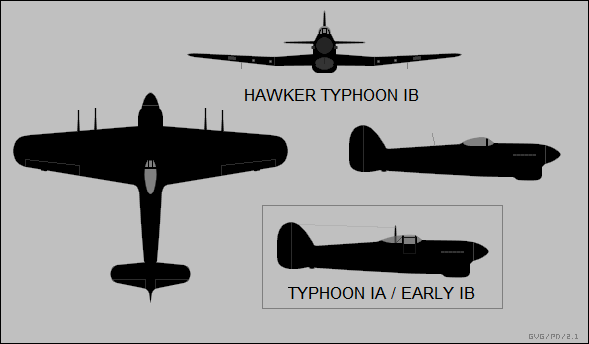
There were less noticeable changes. The exhaust pipes were made longer to reduce the carbon monoxide leakage problems. The de Havilland Hydromatic propeller went from three blades to four. The rigid radio mast on the rear fuselage was replaced by a flexible whip antenna. Pilot armor protection and armor glass were added. Fairings were placed over the four cannon barrels, and improved feed mechanisms were introduced to reduce the jamming problems that plagued them early on. Sighting mechanisms for dropping bombs and firing RPs were improved.
Under the cowling, the Sabre engine was improved as well. The early "Sabre IIA", rated at 1,625 kW (2,180 HP), led to the "Sabre IIB" with 1,640 kW (2,200 HP) and the "Sabre IIC" with 1,685 kW (2,260 HP). Reliability improved significantly after the painful early days, with Bristol engineers methodically adding improvements. However, the Sabre never managed to overcome its tendency to catch on fire on startup. Some sources claim the problems were ultimately mostly due to the failure of engine mechanics to follow factory recommendations on engine service, but whatever the cause, it remained a major problem, with 28 Typhoons burned up in this fashion during 1944 and 1945. A well-known painting of a Typhoon in colors worn in the late summer of 1944 features the following text marked on the aircraft's radiator:
IF THIS ENGINE CATCHES FIRE ON STARTING, DON'T JUST WAVE YOUR ARMS AT THE PILOT -- TRY PUTTING THE BLOODY THING OUT AS WELL.
For better and for worse, the Sabre was a unique engine. Its starter system used what looked like a giant shotgun shell to get the big engine turned over with a loud bang, and once rolling it turned over at fantastic RPM. The Sabre had a distinctive whine that German troops learned to recognize and fear.
BACK_TO_TOP* By the time of D-Day, 6 June 1944, Gloster had built almost 2,000 Typhoons, and they were serving in 26 RAF squadrons. The Tiffies helped pave the way for the invasion by blasting coastal radar stations, and were put to good use as Allied armies advanced, using a "cab rank" system where fighters stood by in the air and awaited calls from ground controllers for targets to destroy. On 17 July 1944, Typhoons attacked a German staff car that turned out to be carrying the commander of German forces opposing the invasion, Field Marshal Erwin Rommel. Rommel was badly wounded; he did not return to action, since he was implicated in a plot to assassinate Adolf Hitler and was ordered to commit suicide.
The high point of the Typhoon's career was the Battle of the Falaise Pocket in the third week of August 1944. German Army divisions, forced by Hitler's obstinate insistence that they stand their ground when they should have withdrawn, were almost completely encircled in the area of the French town of Falaise by the Allied armies. The Germans in the pocket were then crushed by artillery and air strikes. RP-firing Typhoons, or "Rockoons", were significant contributors to the butchery, hitting everything that moved, with Tiffy pilots walking up to a target with cannon fire and then loosing a devastating salvo of RPs. Allied scouts who moved into the area after the shooting died down described it as a "slaughterhouse", with German survivors in numb shock. The Allied victory ended serious German resistance in France.
The Typhoons operated out of hastily built airstrips behind the front lines, flying off pierced-steel planking or steel mesh. That August was as usual hot and dry, and the aircraft's big propeller churned up dust that threatened the Sabre engine. A new dust filter was designed in half a day and put into production the next day; an initial batch was delivered by a Douglas C-47 transport on the third day, and all 500 Typhoons operating from French bases were fitted with the new filter by the fifth day.
On 24 October 1944, massed Typhoons attacked the German 15th Army headquarters at Dodrecht in the Netherlands in a carefully planned assault. The Tiffies struck in three waves, killing two generals and 70 other staff officers.
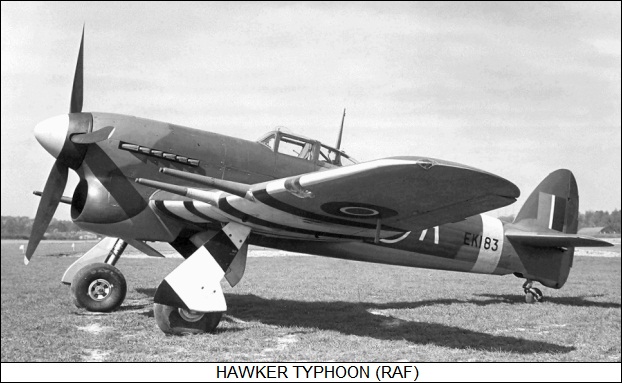
* A total of 3,300 Typhoons was built by Gloster, plus 15 built by Hawker along with the two prototypes. About 60 Typhoons were converted to a photo-reconnaissance configuration designated the "FR.1B", carrying two 20-millimeter cannon and various camera fits.
One Typhoon was experimentally fitted with AI Mark VI radar for use as a night fighter and designated "NF.IB", but this scheme did not go into production. Napier experimented with at least one Typhoon fitted with an annular "ring" radiator that gave it the misleading appearance of a radial-engine fighter, but though the fit was technically very successful and noticeably improved performance, the Air Ministry did not want to disrupt production and nothing came of it. Hawker also experimented with six-cannon armament, but nothing came of that scheme either.
Some Typhoons were used as hacks and target tugs for a short time after the war, but within a few years almost all had been scrapped. The US Army Air Forces received one in 1944 for evaluation at Wright Field, returning it to Britain in 1967. This is the only Typhoon known to have survived to the present.
Despite the fact that the Typhoon became a significant asset to the Allied war effort, the aircraft's teething problems and its limitations could not be ignored. Even when it worked as planned, it was a handful to fly, due to its great weight, high wing loading, and other peculiarities. Not all its pilots loved the machine, and it would be remembered almost as much for its faults as for its virtues.
BACK_TO_TOP* While Hawker and the RAF were struggling to turn the Typhoon into a useful aircraft, Hawker's Sydney Camm and his team were rethinking the design. The Typhoon's thick, rugged wing was partly to blame for some of the aircraft's performance problems, and as far back as March 1940, a few engineers had been set aside to investigate the new "laminar flow" wing, which the Americans had implemented in the P-51 Mustang.
The laminar flow wing had a maximum ratio of thickness to chord of 14.5%, in comparison to 18% for the Typhoon; the maximum thickness was also moved back towards the middle of the cross-section. The new wing was originally longer than that of the Typhoon, at 13.1 meters (43 feet), but then the wingtips were clipped off and the wing became shorter than that of the Typhoon, at 12.5 meters (41 feet). The new wing cramped the fit of the four Hispano 20-millimeter cannon, and so the cannon were moved back further into the wing, and the wing was extended into an elliptical shape to accommodate them. The new elliptical wing had greater area than the Typhoon's. Camm, noted for an edged sense of humor, later remarked: "The Air Staff wouldn't buy anything that didn't look like a Spitfire."
Another important feature of the new wing was that radiators for the new Sabre IV engine were fitted into the leading edge of the wing inboard of the landing gear. This eliminated the distinctive "beard" radiator associated with the Typhoon and improved aerodynamics, but also displaced fuel tanks that had been fitted into the leading edge of the Typhoon's wing. This greatly reduced wing fuel capacity, but Hawker engineers found they could stretch the fuselage 53 centimeters (21 inches) ahead of the cockpit to accommodate more fuel storage in the fuselage. The longer nose did not seriously impair the pilot's forward view, but the tailfin had to be extended.
* The new design was basically solid by October 1941, and the Air Ministry issued a specification designated "F.10/41" that had been written to fit. A contract for two initial prototypes was issued the next month. The aircraft was originally named the "Typhoon Mark II", but was renamed "Tempest" in January 1942, when more prototypes with various experimental configurations were ordered.
The first Tempest prototype flew on 2 September 1942. This aircraft was really just a Typhoon fitted with the new elliptical wing, and retained the Tiffy's frame canopy, automobile doors, and Sabre II engine; it was quickly fitted with a bubble canopy and taller tailfin. Test pilots found the Tempest a great improvement over the Typhoon. The Air Ministry had already ordered 400 Tempests in August, but production of the new Sabre IV engine ran into protracted problems and delays. The second prototype, the first with the Sabre IV and designated "Tempest Mark I", did not fly until 24 February 1943. This prototype also had the older Typhoon cockpit and tailfin at first. Elimination of the "beard" radiator did much to improve performance; the Tempest Mark I was the fastest thing Hawker had built to that time, attaining a speed of 750 KPH (466 MPH).
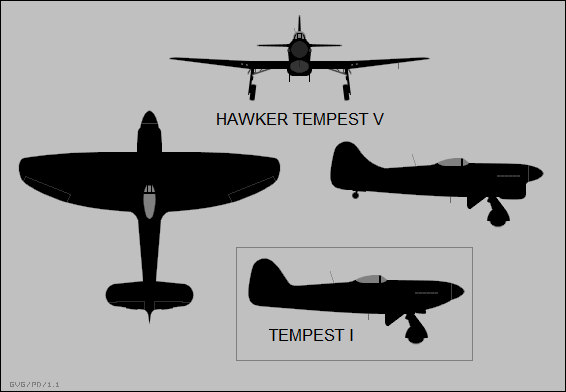
However, only one Mark I was built. Sabre IVs were still unavailable, so Camm simply went into production using the Sabre II with the old beard radiator. The first "Tempest V", as this variant was known, rolled off the production line on 21 June 1943. The first 100 Tempest Vs delivered had the long-barreled Mark II Hispano cannon, and such aircraft were referred to as "Tempest V Series 1". Later production, delivering a total of 800 aircraft known simply as "Tempest V", used the short-barreled Mark V Hispano cannon, eliminating the protruding barrels that had been a trademark of the Typhoon.
___________________________________________________________________
HAWKER TEMPEST MARK V:
___________________________________________________________________
wingspan:
12.5 meters (41 feet)
wing area:
28.05 sq_meters (302 sq_feet)
length:
10.3 meters (33 feet 8 inches)
height:
4.9 meters (16 feet 1 inch)
empty weight:
4,080 kilograms (9,000 pounds)
max loaded weight:
6,140 kilograms (13,540 pounds)
maximum speed:
686 KPH (426 MPH / 370 KT)
service ceiling:
11,125 meters (36,500 feet)
range:
2,460 kilometers (1,530 MI / 1,330 NMI)
___________________________________________________________________
* The jump from Tempest Mark I to Tempest Mark V raises the question of what happened to Marks II, III, and IV. The Mark II was a Centaurus-powered Tempest, and as will be explained below, it did reach production. Marks III and IV were to be powered by different variants of the Rolls-Royce Griffon vee-12 engine. One Mark III was actually built, though as described below not as a Tempest, while the Mark IV was canceled unflown.
BACK_TO_TOP* The Tempest V was in the hands of operational squadrons by April 1944, where it profitably carried on in the low-level attack tradition of the Typhoon, which it was replacing as Tempest production ramped up. However, in June 1944, the first German V-1 pulsejet flying bombs were launched against London, and the Tempest's excellent low-altitude performance made it one of the preferred weapons for dealing with the fast-flying little missiles. Tempest squadrons racked up a considerable percentage of the total RAF kills of the flying bombs.
In the meantime, the Tempest continued strikes in support of Western armies advancing across Europe, and engaged Luftwaffe aircraft when they could be found. Tempests circling Luftwaffe airfields also scored a number of kills on new German jets such as the Messerschmitt Me 262, which was helpless on landing approach since its jet engines could not throttle up quickly.
* While Hawker was working toward the introduction of the Tempest V, Sydney Camm and his crew were also revisiting the Centaurus radial engine, incorporating it into two other Tempest prototypes. The first Centaurus Tempest, or "Tempest Mark II", flew on 28 June 1943 with a Centaurus IV, and was soon followed by the second. The radial engine installation owed much to examinations of a captured Focke-Wulf Fw 190, and was unprecedentedly clean and effective. There were problems with vibration, but they were fixed by addition of six rubber shock mounts.

The Centaurus was generally regarded as superior to the Sabre, particularly in terms of reliability. The Centaurus engine and Tempest airframe proved an excellent match. The combination looked so promising that a contract for 500 of the type was placed as far back as September 1942, but Gloster was overloaded with production of the Typhoon and development of the Meteor, and there was no way the company could handle the additional load. Tempest Mark II production ended up in the hands of Bristol, and the switch delayed production even more. The first Tempest II was rolled off the line on 4 October 1944, but then production was shifted back to Hawker.
A total of 452 Tempest IIs was built, including 136 basic Mark IIs and 316 "Fighter Bomber Mark IIs (FB.II)". They were built mostly by Hawker and generally with Centaurus V engines, and of that number 300 were completed after the war. The Tempest II, despite its slightly improved performance and better reliability, never saw combat. Tempest IIs produced during the war were intended for combat against the Japanese, but the Pacific War ended before they could be deployed. 89 Tempest FB.IIs were passed on from the RAF to the Indian Air Force in 1947, while another 24 were passed on to the Pakistani Air Force.
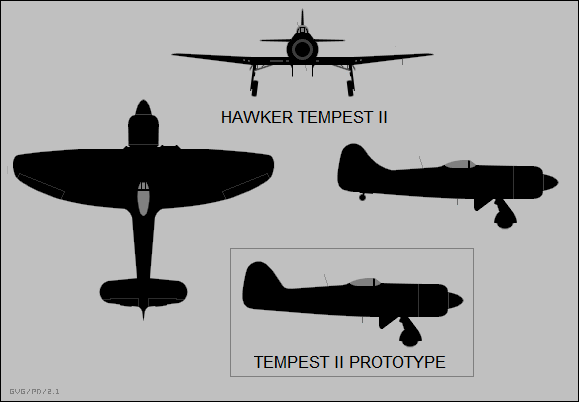
* Various engineering refinements that had gone into the Tempest II were incorporated into the Tempest V to produce the "Tempest VI", fitted with a Sabre V engine with 1,745 kW (2,340 HP). Hundreds of Tempest VIs were ordered, though only 142 were built. They were the last Tempests built, and in fact the last piston engine fighter in RAF service was a Tempest VI, which was in use as a target tug when it was retired in 1953.
BACK_TO_TOP* The convoluted threads that make up the history of the Tornado, Typhoon, and Tempest -- with all their confusing engine fits, prototype builds, and mark numbers -- were finally tied up with the last of the line, the "Fury" and "Sea Fury".
In September 1942, in reflection of an RAF need for a long-range fighter for Far Eastern service that could match agile Japanese fighters, Camm had proposed an "Improved Tempest" or "Tempest Light Fighter (TLF)", which was basically a Tempest with the wing center section removed. The reduced weight, it was hoped, would result in higher maneuverability. Three different variants with different engine fits were envisioned:
The fuselage structure was also redesigned and modernized, with the cockpit raised for a better view, and the tailfin was altered as well. The Air Ministry was enthusiastic enough to write Specification "F.2/43" in January 1943 around the TLF concept, and a few months later Camm managed to convince the Admiralty that the basic design could meet Naval Specification "N.7/43" as well, which defined a shipboard interceptor. Hawker and Boulton-Paul were to cooperate in manufacturing the TLF.
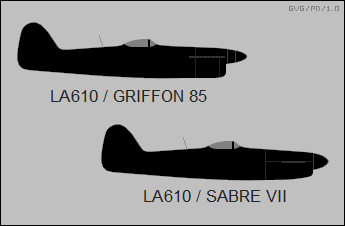
A number of TLF prototypes were built to explore different engine fits and other modifications:
To increase the confusion, the Sabre-powered Fury design was used as the basis for a new jet fighter design, with the designation "P.1040". This eventually emerged as the Hawker "Sea Hawk" naval fighter, with so many modifications from its Fury ancestor as to make any connection difficult to see.
The RAF had considered putting the Fury into production, apparently with the Centaurus engine, but after the war, the contracts were canceled. Jet fighters were the future of the RAF. Hawker concentrated on the Sea Fury for the Royal Navy, since the admirals felt they needed to stay with piston fighters for a few years until the complications of operating jet aircraft from carriers were worked out. With postwar production cutbacks, Boulton-Paul would never roll out any Furies or Sea Furies.
BACK_TO_TOP* The first Sea Fury prototype (SR661) flew on 21 February 1945. It was fitted with a Centaurus XII engine, a four-blade propeller, and an arresting hook, but lacked folding wings. The second prototype (SR666) flew on 12 October 1945, and featured a Centaurus XV engine with 1,900 kW (2,550 HP) on improved shock mountings, a distinctive five-blade Rotol propeller, an arresting hook, and wings that folded hydraulically. A third prototype with a similar level of equipment fit was partially completed by Boulton-Paul and finished by Hawker.
The first production Sea Fury, designated "F.X" (for "Fighter Mark X"), flew on 7 September 1946, and featured small changes from the first prototype, such as a longer arresting hook. 50 Sea Fury F.Xs were built, with introduction to Royal Navy Fleet Air Arm (FAA) service with Number 802 squadron in May 1948.
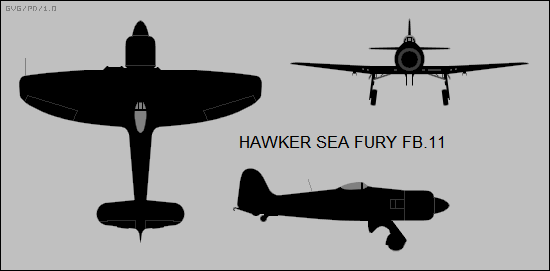
The Sea Fury F.X retained the standard four 20-millimeter cannon armament of its ancestors; the cannon could be fired in pairs or all together. It is unclear what provisions the F.X had for external stores, but since the future of piston engine fighters in the air superiority role was becoming increasingly dim, the design was tweaked for the fighter-bomber role, becoming the Sea Fury "Fighter-Bomber Mark XI (FB.XI)", later redesignated "FB.11". The FB.11 featured additional armor and other protection, and could carry external stores such as two 450-kilogram (1,000-pound) bombs, napalm tanks, sonobuoys, or twelve RPs, as well as rocket-assisted take-off boosters.
___________________________________________________________________
SEA FURY FB MARK 11
___________________________________________________________________
wingspan:
11.7 meters (38 feet 5 inches)
wing area:
26.01 sq_meters (280 sq_feet)
length:
10.6 meters (34 feet 8 inches)
height:
4.84 meters (15 feet 10 inches)
empty weight:
4,190 kilograms (9,240 pounds)
max loaded weight:
6,645 kilograms (14,650 pounds)
maximum speed:
740 KPH (460 MPH / 400 KT)
service ceiling:
10,910 meters (35,800 feet)
range, no drop tanks:
1,125 kilometers (700 MI / 610 NMI)
___________________________________________________________________
The Sea Fury was an outstanding aircraft, a tough customer in the attack role, but with light and responsive controls as well as excellent performance. A Sea Fury ferried by pilot Neville Duke from London to Karachi, Pakistan, in 1949 set a speed record during the London-to-Rome leg of the trip, covering 1,448 kilometers (880 miles) in 2 hours 31 minutes 51 seconds, with an average speed of 574.3 KPH (356.9 MPH). Time for the entire trip of 4,827 kilometers (3,000 miles) was 15 hours 20.5 minutes, with an average speed of 412.1 KPH (256.1 MPH). This Sea Fury was in entirely stock configuration.
A total of 615 FB.11s was built; some were supplied to Australia and Canada. The Sea Fury was roughly comparable to the US Navy Grumman F8F Bearcat; the Sea Fury was judged inferior to the Bearcat in terms of maneuverability and rate of climb, but superior in terms of accurate weapons delivery and operations under instrument flying conditions.
* The FB.11 proved itself a capable warrior in Korea, the type arriving in Korean waters with Number 807 Squadron on board the carrier HMS THESEUS in October 1950. They were later joined by more Sea Furies on the Royal Navy carriers HMS THESEUS, OCEAN, and GLORY, and the Royal Australian Navy carrier HMAS SYDNEY.

The Sea Fury performed air strikes with any ordnance it could carry, including sea mines. Weapons delivery was extremely accurate for the days of unguided weapons, and one Sea Fury even shot down a MiG-15. On 9 August 1952, a flight of four FB.11s from the HMS OCEAN was on a "train busting" mission when they were jumped by eight MiG-15s. The MiG pilots foolishly decided to get into a "turning contest" with the agile Sea Furies, and a Sea Fury piloted by Lieutenant Peter "Hoagy" Carmichael managed to get on the tail of a MiG and smash it up with his four 20-millimeter cannon. Two other MiGs were damaged; the Sea Furies returned safely.
That was apparently the only air-to-air victory by a British pilot in a British aircraft in the Korean War, which is not too surprising since the FAA was focused on the close-support role. Some sources claim that a Sea Fury shot down a second MiG. Whatever the case, several Sea Furies were lost to enemy fighters in return. The Sea Fury remained the foremost FAA single-seat fighter, until it began to be replaced by the Hawker Sea Hawk in 1953.
* Although most of the Sea Furies were FB.11s, smaller quantities of other variants were produced as well. 60 "T.20" trainers were built, featuring tandem cockpits connected by a Perspex tunnel, and a periscope in the rear cockpit for the flight instructor. The initial prototype for the trainer actually had separate canopies, but airflow around the front canopy damaged the rear canopy in tests, and so the tunnel was added. Armament was reduced to twin 20-millimeter cannon. A reconnaissance version was considered, but was abandoned since nobody could figure out a clean way to fit the cameras.
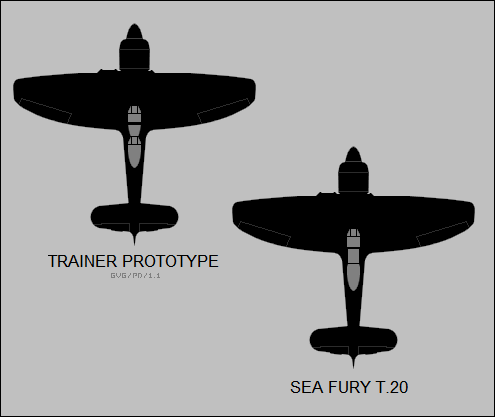
The Royal Netherlands Navy also flew the Sea Fury. Hawker built ten "Mark 50s" for the Dutch, followed by 12 "Mark 51s", and then Fokker built 210 Mark 51s under license.
Although the RAF never flew the Fury operationally, in yet another tangled branch of the story, the Sea Fury was modified slightly for land-based operation, and then sold to Iraq and Pakistan as, of course, the "Fury". Iraq obtained 30 Furies and Pakistan obtained 93, with five of the Pakistani order being converted Royal Navy FB.11s. The two countries also obtained Fury trainers, generally equivalent to the Sea Fury T.20, with Iraq purchasing two and Pakistan obtaining five. Work on the Fury trainer had actually been initiated by the Iraqi request, with the Admiralty expressing interest after the project had been set in motion.
Standard production FB.11s and T.20s were exported to other countries. Egypt bought 12 new FB.11s; Burma bought 18 used FB.11s and 3 new T.20s; and Cuba bought 15 new FB.11s and 2 new T.20s. West Germany bought 10 used T.20s rebuilt as target tugs.
* The fact that the Sea Fury's service took place after 1945 meant that it was missed by the mad scramble to scrap that destroyed so many combat aircraft at the end of World War II, and so many Sea Furies still survive. They have become a preferred mount for air racing. For example, the 1999 Reno air races in Nevada featured eight Sea Fury contenders, some in military colors and markings. Interestingly, seven of the eight aircraft were powered by the Wright R-3350 radial driving a four-blade propeller, and the other was powered by the Pratt & Whitney R-4360.
BACK_TO_TOP* I decided to write up the Typhoon, Tempest, and Sea Fury in a single document since none of the three seemed to be prominent enough in itself to result in much of a write-up. That proved to be wiser than I knew, because the development of these three lines of aircraft turned out to be so intertwined that trying to document them separately would have been painful.
Incidentally, there is a myth in circulation that the Sea Fury was based on the Fw 190. In reality, the resemblance between the two aircraft is superficial, and any consideration of the design evolution of the Hawker fighter shows the idea to be nonsense. The British didn't get their hands on an FW-190 until mid-1942, well after the flight of the Centaurus-powered Tornado that was the design ancestor of the Sea Fury. It seems the only major feature the Sea Fury owed to the FW-190 was the engine mounting scheme.

* Sources include:
* Revision history:
v1.0 / 01 mar 00 v1.1 / 01 apr 01 / Review & polish. v1.2.0 / 01 apr 03 / Review & polish. v1.2.1 / 01 apr 05 / Review & polish. v1.2.2 / 01 apr 07 / Review & polish. v1.3.0 / 01 jan 10 / Revision of illustrations. v1.3.1 / 01 dec 11 / Review & polish. v1.3.2 / 01 nov 13 / Review & polish. v1.3.3 / 01 oct 15 / Review & polish. v1.3.4 / 01 sep 17 / Review & polish. v1.3.5 / 01 aug 19 / Review & polish. v1.3.6 / 01 jun 21 / Review & polish. v1.3.7 / 01 may 23 / Review & polish. v1.3.8 / 01 may 25 / Review & polish. (++)BACK_TO_TOP
